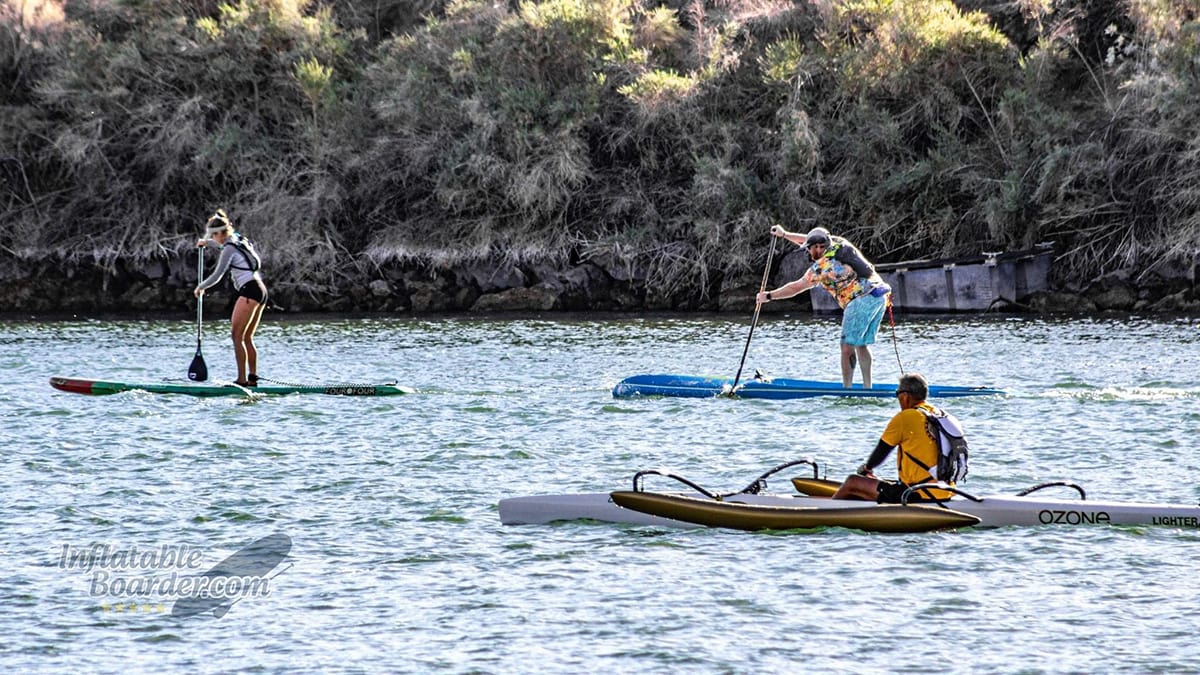
The 13th annual Another Dam Race in Parker, AZ, was a fantastically fun event and wonderful first race.
I have a slightly competitive side. From Tae Kwon Do as an 8 year old, to intramural rugby in high school and hurling in college, and now pickleball and paddleboarding as an adult, competition has never really been my primary focus, but has always been present. Why? Because it’s fun! I love to test myself and push my boundaries to see what I’m capable of and competitive events provide both goals and results.
Getting Ready for My First “Real” Race
I’ve paddled in a few races locally. Some of them I’ve even organized myself (since there’s a lack of SUP racing otherwise). They’ve absolutely been fun and sometimes even help promote some local nonprofit groups. But I hadn’t ever really done a “Real” SUP race.
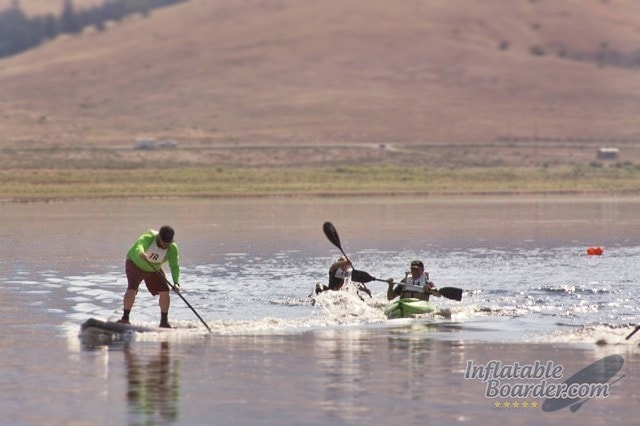
My first SUP race back in 2018. I was on a 34” wide board and had terrible technique for paddling fast – but it was still fun!
I’ve known about Another Dam Race for a few years now, but for various reasons I hadn’t been able to attend until this year. This year everything aligned and I was out of excuses. I registered a bit late (3 weeks before the race) and made sure to schedule a few training sessions.
I set two goals for myself:
- 1) Beat my flatwater training time
- 2) Don’t be last
I opted for the 5 mile short course instead of the 11 mile long course. Did I think I could paddle for 11 miles continuously? Yes. Did I think I could be anywhere near competitive in doing so? No. But I was confident that I could put up a competitive time in the 5 mile race.
Another Dam Race is held near Parker, AZ, on the Colorado River. The race starts and ends at the same point on the river – so the first half you are paddling up-stream against the current and the second half is down-stream with the current. Even though the current wasn’t incredibly fast, when the water works against you at ~2 miles per hour, it takes a lot of energy to overcome that with any amount of speed.
I was only able to get a couple of training sessions in on my race SUP (an NSP Ninja 14’x25” carbon fiber SUP) and both were on flat water. I hadn’t ever tracked a 5 mile flatwater paddle for speed before, and I was a little disappointed that my training time was about 1 hour, 12 minutes (about 4.2 MPH average speed), but at least I knew where I was starting from. Of course that was on flat water, so I had no idea what time I should expect on the Colorado River. I figured as long as I could find someone who is ever so slightly faster than me, and try to stick on them as best as I could then I should be fine.
The drive to Parker was interesting as I encountered high wind and winter driving conditions crossing the Continental Divide, but I did arrive with enough time to get a good dinner at a local pizza place before calling it a night at the hotel.
Race Day
The rest of this blog post is going to be a detailed account of the race from when I woke up through the awards ceremony. I also shot a little video at the race. If you’d prefer to watch that (though it’s not quite as detailed, and a little more chaotic) check out the Inflatable Boarder YouTube channel and make sure to subscribe!
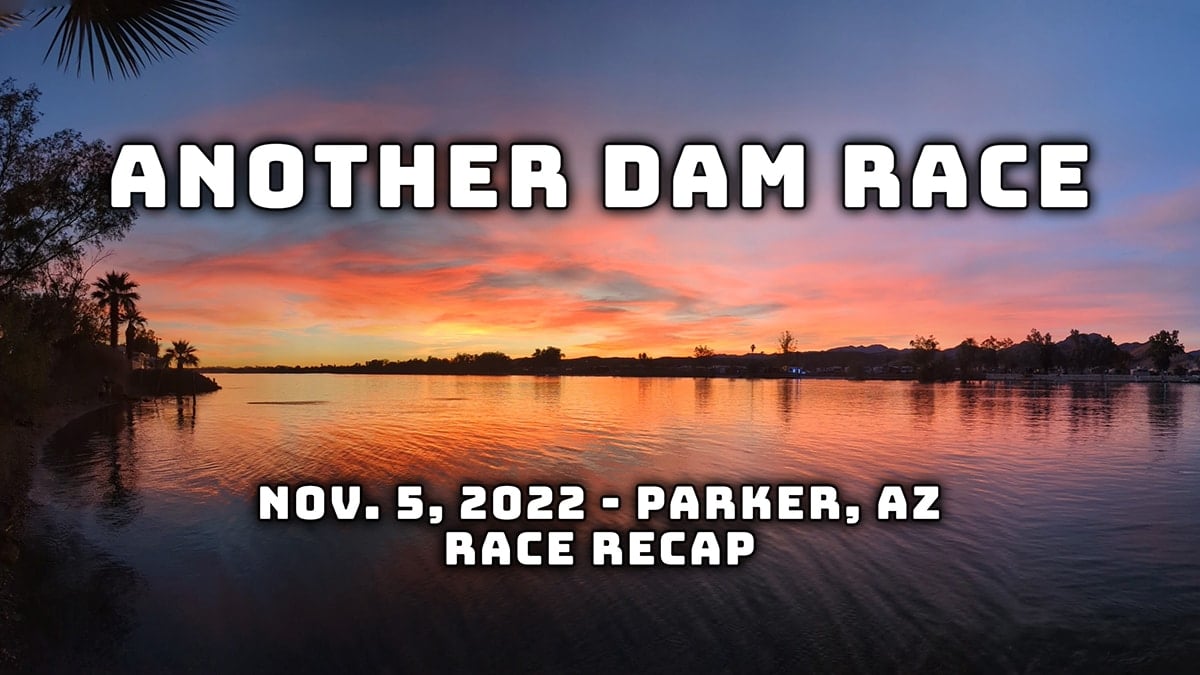
Check out the ADR Video Recap
Google Maps did me dirty and couldn’t actually figure out where I needed to go (No, Google, I’m not going to ram the County Park fence and plow my way through a campground to get there). Eventually I found the right entrance and was able to get in and parked without too much of a problem. Finding the registration area was another matter. The registration area was listed online to be at Location A and open from 5-7am for day-of registration and packet pick up. It was not at Location A. I asked the person directing parking, she told me Location B. It was not Location B. I wandered around for a bit until I found another group of racers who identified the race coordinator for me (at Location C). It was about 6:30 am at this point and they were still setting up the registration area. No worries, delays happen, but that was a little frustrating.
I got checked in, got my racer number, and started getting my equipment ready. Around 7:30 things didn’t seem like they were ready to get started in half an hour, and that’s when I overheard someone say the start was postponed until 9:00 am. Apparently they made a post on the facebook event about it that morning, but no other communication to the racers. As far as “bad” things to happen on race day, this was actually welcome as it gave me more time to warm up (both physically and environmentally). However, it did mess with my moderately-planned out eating schedule. Now I had an extra hour before the race. Not really enough time to eat anything of substance, but enough time that my peanut butter and oatmeal breakfast was starting to wane.
I spent the rest of the time before the race warming up and stretching on land while making friends with the other SUP racers, chatting about the event, getting tips and advice on the start (well, mostly a warning that it would be chaotic), and of course asking questions about everyone’s equipment, how they like their boards, etc.
After an opening ceremony by Kimokeo Kapahulehua, a Hawaiian elder, and the brief racer’s meeting, everyone started getting their canoes, kayaks, and SUPs in the water. Now it really was only 30 minutes until the horn.
And We’re Off!
After a brief 10 minute warm up paddle, the river began to fill with paddlers. OC-6 boats dominated the starting area with smaller teams and individual paddlers filling in behind.
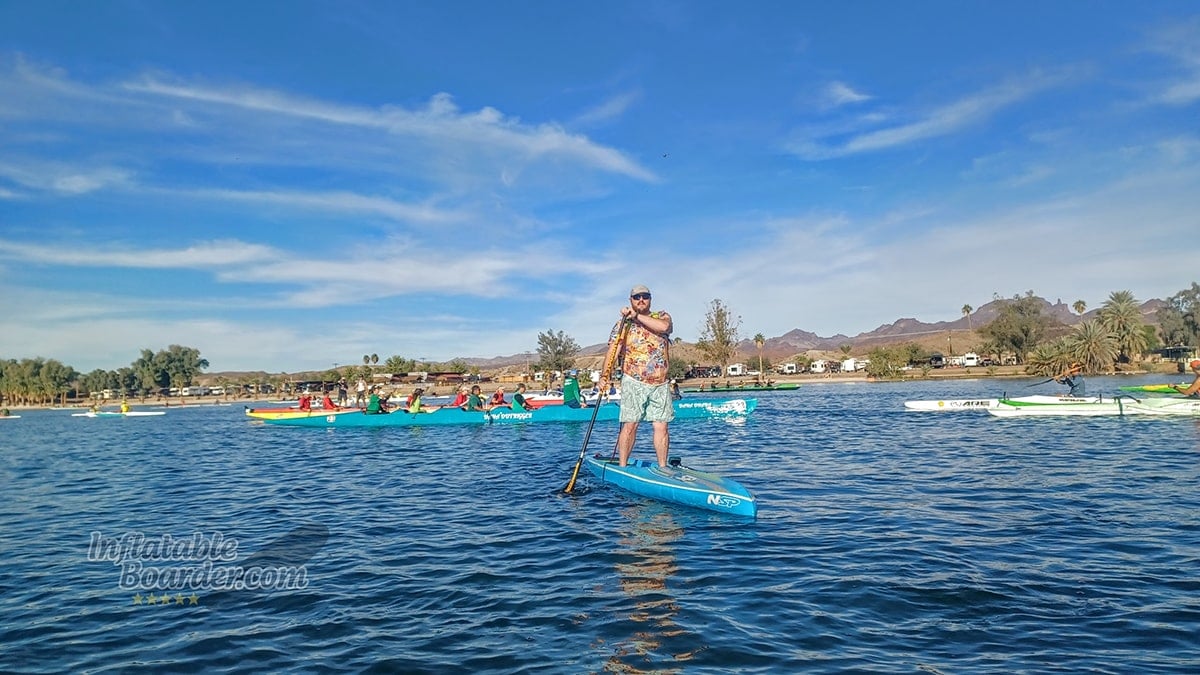
Before the Horn – this photo doesn’t even begin to show the number of racers at the start line. Over 400 people took part this year. Photo by @supchez on instagram.
The race began with the OC-6 teams taking off, followed by OC-4, OC-3/2, OC-1, Surfski, Kayak, 14’ SUP, and then the recreational paddlers. Each group started only 30 seconds after the previous group. With 400+ paddles propelling thousands of pounds of boats through the water, things got a little bouncy. One paddler told me before the race that it feels like you are paddling on ping pong balls. He was right.
When you paddle in chop from wind, waves, or even boat wake, it normally has some degree of consistency. When the chop is from hundreds of paddle craft, it’s chaos. I quickly found that I had to shift much farther back on my SUP than normal to keep my nose from pearling too far under water. Staying loose and keeping the paddle blade moving was the only way to stay upright at the start – and not everyone did. I saw a few people out of the corner of my eye go for a quick swim. My philosophy on how to be as fast as possible is to give priority to stability, not maximum theoretical speed. Could I paddle a 23” wide race board? Yes. Would I have been faster on it? No. The marginal gain in speed from a narrower board would be completely overshadowed by a single fall at the start.
After almost a half mile the water began to calm down as the racers spread out. Here I was able to find a few “rabbits” to chase. I picked paddlers that were close by and close to my speed, but just a little bit faster than me. This gave me a target to focus on, and – if I could get close enough – someone to draft off of. Drafting in SUP racing can be really, really helpful, but requires you to paddle within inches of the lead paddler’s tail to really get the full effect. As the lead paddler drifts side to side while paddling, you have to drift exactly with them. I caught a few, short, breaks drafting behind some people, but ultimately I found the energy and focus I needed in order to stay right behind them was better used paddling my own race. For the next two miles paddlers spaced out more and more. Paddling against the Colorado River I was holding around 3.25-3.5 MPH – not incredibly fast, but I felt that it was a good speed going against the current.
As I got to the turn-around buoy for the 5 mile course I set up to make as quick of a turn as I could, but still stay upright. Pivot turning is a really fun skill, and can also be really useful in certain situations (racing being one of them). Pivot turning these narrow race boards takes a lot of practice to do effectively, and they can still be quite squirrely. Again, my philosophy on speed is it’s better to stay standing than go swimming, so I took a more conservative pivot turn – not going all the way to the tail, turning toward my front side to be on my more comfortable side, slowing down a little, taking three strokes to turn instead of one, etc. While it’s not as exciting, it absolutely did the trick and I was able to get right back up to speed.
Just after the turn-around I was passed by a tandem SUP team – and it was actually paddled by a few people that I knew! One of them was a participant with me in my ACA Level 3 SUP Instructor course this spring, and the other was one of the owners of Riverbound Sports in Phoenix, AZ (I had actually stopped there on the way to Parker to get a proper travel bag for my race board). They were paddling a Red Paddle Co. Dragon multi-person race iSUP, and they were flying! I was able to draft behind them for over a quarter mile, but ultimately two engines were faster than one and they pulled ahead.
At this point in the race I was surprisingly alone. There were other paddlers around, but very few and rather spread out. I kept trucking along, now at a much faster 5.5 MPH average. Around Mile 4 I began to feel a bit odd. My stomach was doing some strange things and I got a little light headed. I was wearing a small hydration backpack with water, and had been sipping on it throughout the race, but it wasn’t quite enough. I was definitely running low on energy. I knelt down for about 20 seconds and stretched out a little to take a breather and relax my muscles. After I got back up I felt a little better, but was hit by a boat wake I didn’t see coming and took a swim. It was a bit of a shock, but I got right back on the board and started paddling again. The water helped cool me down and gave me a bit of an adrenaline boost.
As I neared the finish line I knew I wanted to make sure I had given it my all and not left anything behind, so I began spooling up to a sprint for the last 100 yards. My paddling cadence climbed as did my speed. I saw on my speed coach that I hit 6.5 MPH at one point. I was breathing hard and forcing myself to keep up this higher cadence. I was totally focused, but focused on the nose of my board (not ideal). As I came to the finish line I took one more stroke. I’m not sure if maybe I didn’t clear my paddle blade from the water before moving it forward again, or maybe I started pulling too early before the paddle blade had fully caught in the water. Either way, as I took that last stroke my upper body went well over my toes and my paddle wasn’t there to give me any support. I went headfirst into the water right at the finish line. I was a bit embarrassed, to say the least.
I put my paddle on the board and tried to pull myself up, but only managed to flip my board over. I knew I was tired, but I didn’t know I was so tired I couldn’t get back on my SUP! There was actually a moment of panic as I floated with my board. Am I going to be able to get back on? Should I pull my inflatable PFD ripcord? Ask another paddler for help? After a few seconds I calmed back down and decided to just hold on and relax for a good, slow, ten-count and try again. That time I was able to get back on my board (and by then an OC-1 paddler had started making her way to me in case I needed help). The paddling community – even in competition – is one of the nicest, most supportive groups of people I’ve encountered.
After I was back up, I double checked that the timers had me clocked in, and I made my way over to the side of the river, out of the way of the race. I mingled with a few other SUP paddlers as we watched more and more people and teams cross the finish line. Eventually I started to get cold (since I was most thoroughly soaked at this point) so I paddled over to the marina and got out of the water.
Results and Final Thoughts
First and foremost – above everything else – I had an absolute blast. It was a great event and I got to meet and paddle with some really great people.
Did I meet my goals?
Goal 1: Beat my training time. According to my watch (I started at my division’s horn) I finished in 1:09:05, and the official race time (from the first group, unadjusted for the staggered start) was 1:10:56 – both times were faster my flatwater 5 mile training time of 1:12:00.
Goal 2: Don’t be last. Well, I finished in Third Place in my division (out of four) and 9th Place for all 14’ SUPs (out of 19) in the 5 mile course. Yay!
When I heard my name and number called at the award ceremony I was absolutely sure that I heard wrong. I actually asked the race coordinator to double check! When I found out I wasn’t third out of three, I was even more excited! I competed in the Men’s Open division for SUP (basically 16-50 year olds) and was fully expecting it to be a very competitive group. The first place paddler in my division absolutely smoked me with a time of 1:03:36, but I managed to beat the fourth place paddler by nearly 14 minutes! The fastest 14’ SUP paddler in the short course had a blistering 59:05 unadjusted time (so likely closer to 58 minutes actual time).
But you don’t have to be ultra competitive to have fun at races like this. There’s no money on the line. In fact, the winners of each division got either a glass stein for first place, pint glass for second place, or shot glass for third place.
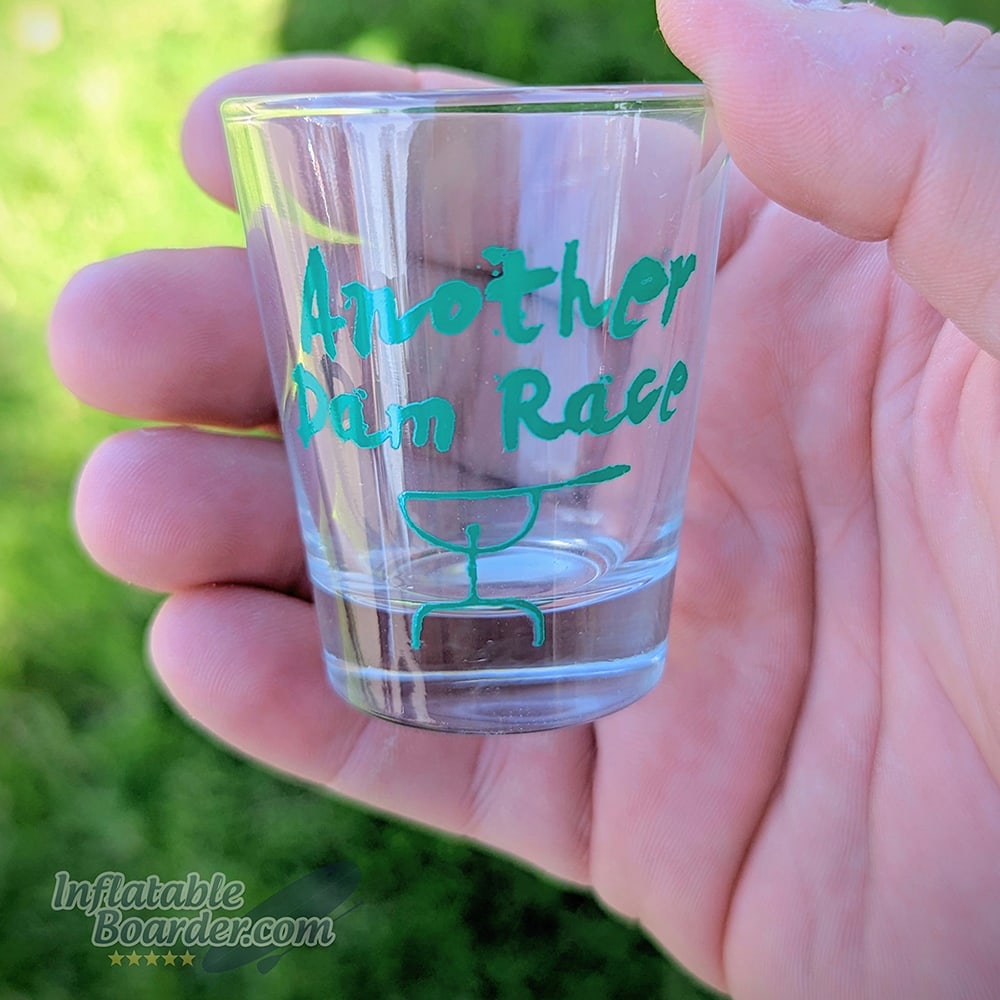
Big Money for the Podium!
A few final takeaways for myself (and of course, feel free to use them yourself as well).
1) Train More. I only put in a few honest training sessions before this race. Paddling five miles is nothing for me, but paddling five miles in a race was totally different (especially with half going against the current).
2) Mental Stamina. After the initial chaos of the start I did notice my mind drifting either to random thoughts, hyperfocusing on my board, or over-thinking any decisions I needed to make. This also comes with practice, but my strategy going in was to focus on counting my strokes. 15, switch, 15, switch, etc. But instead I found it much harder to do that with other paddlers around me, figuring out who to follow, if I should try to draft, etc.
3) Energy. Again, this goes with more experience and practice, but taking the time to figure out what to eat and when can make a big difference in finishing strong or just barely finishing. A delayed race doesn’t help, but I could have put some more thought into this part.
I’ve got a lot to work on for my racing, and now that I’ve got a good taste for it, I look forward to spending more time getting ready for the next race. ADR is on the calendar for next year already (Nov 4-5, 2023!), and I’m going to pick a few other races to paddle next year as well. I’ll keep updating the blog with progress and news, race announcements and schedules.
Until then, have fun and safe paddling!






Leave a Reply